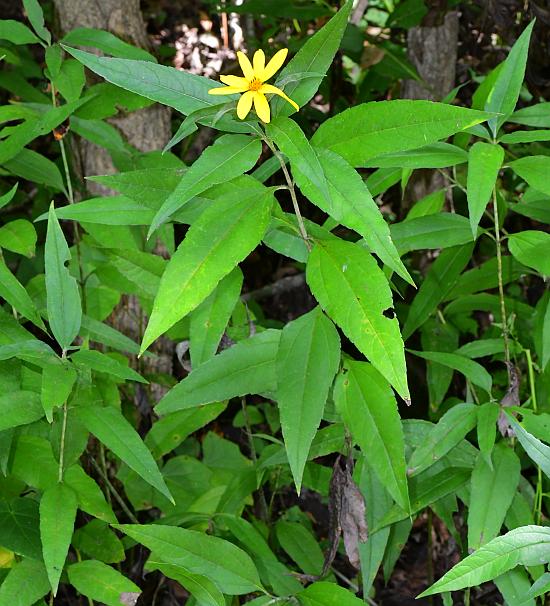Helianthus strumosus L.
Pale-Leaved Sunflower

Native
CC = 7
CW = 0
MOC = 51
© SRTurner
Helianthus strumosus L.Pale-Leaved Sunflower | |
 |
Native CC = 7 CW = 0 MOC = 51 |
© SRTurner |
|
Family - Asteraceae/Heliantheae Habit - Perennial forb, with slender to stout, usually long-creeping, branched rhizomes (the branches sometimes with small tubers at the tip), usually occurring in dense colonies.
Stems - Ascending to erect, to 2.0 m, usually solitary, smooth and glabrous below the inflorescence or the uppermost portion of the stem sparsely pubescent with short, stiff, loosely ascending, pustular-based hairs, often somewhat glaucous.
Leaves - Alternate, simple, petiolate. Leaves well developed along the stem (usually with 8-20 nodes), usually all opposite, mostly short-petiolate, the petioles of the larger leaves 1-2 cm long. Leaf blades 4-20 cm long, 1-10 cm wide, relatively thick-textured, lanceolate to ovate (mostly 2-5 times as long as wide), flat, not folded longitudinally, rounded to broadly angled or short-tapered at the base, tapered to a sharply pointed tip, the margins finely toothed to entire, flat, the upper surface roughened with moderate to dense, minute, stout, pustular-based hairs, the undersurface usually pubescent mainly along the major veins, pale green to silvery, often somewhat blotchy, also with sparse to moderate, sessile, yellow glands, with 3 main veins, the lateral pair branching from the midnerve at or just above the base of the blade, arching upward.
Inflorescences - Solitary terminal heads or appearing as open panicles.
Heads - Radiate. Involucre 7-12 mm long, 8-20 mm in diameter, the bracts in 3 or 4 subequal, overlapping series, lanceolate, tapered to a sharply pointed, loosely ascending to spreading or recurved tip, the margins with an irregular fringe of short, spreading to ascending hairs, the outer surface glabrous or more commonly sparsely to moderately pubescent with short, stout, ascending, often pustular-based hairs, sometimes also with minute, sessile, yellow glands. Receptacle convex to short-conical, the chaffy bracts 5.0-6.5 mm long, narrowly oblong to narrowly oblong-oblanceolate, often with 3 short-tapered, sharply pointed lobes at the tip, these green or straw-colored, the outer surface minutely hairy, especially toward the tip.
Flowers - Ray florets 8-15, sterile, the corolla 1.5-3.0 cm long, the outer surface usually with sparse, minute hairs and scattered, minute, sessile, yellow glands. Disc florets perfect, the corollas 5.5-6.5 mm long, yellow, the lobes often minutely hairy on the outer surface. Pappus of 2 scales 1.5-2.5 mm long, these lanceolate to narrowly triangular, tapered to a sharply pointed, often minutely awnlike tip.
Fruits - Achenes 4.0-5.5 mm long, wedge-shaped to obovate, somewhat flattened and more or less bluntly 4-angled in cross-section, the surface glabrous or with a few minute hairs at the tip, uniformly brown or with fine, darker and lighter brown mottling. Flowering - July - September. Habitat - Bottomland and mesic forests, streambanks, bases of mesic slopes and bluffs, fens. Origin - Native to the U.S. Lookalikes - H. hirsutus and H. tuberosus in particular; more generally, other species of Helianthus; also Heliopsis helianthoides. Other info. - This species is one member of what has been called the "Helianthus hirsutus complex," a group of 3-4 species which appear very similar, exhibit considerable morphological variation which leads to feature overlap, and thus can be difficult to distinguish. Helianthus strumosus is usually fairly distinct due to its habitat, whitened leaf undersides, smooth stems, and petiolate leaves. It is restricted to fairly moist sites, and the leaves are usually significantly larger than those of H. hirsutus. The smooth stems and (usually) all-opposite leaves distinguish it from H. tuberosus. The leaf petioles provide a distinction from H. divaricatus. However, is should be recognized that many individuals in the complex will exhibit confusing combinations of characters and/or intermediate character states. Photographs taken at Matson Hill County Park, St. Charles County, MO, 8-29-2021 (SRTurner). |